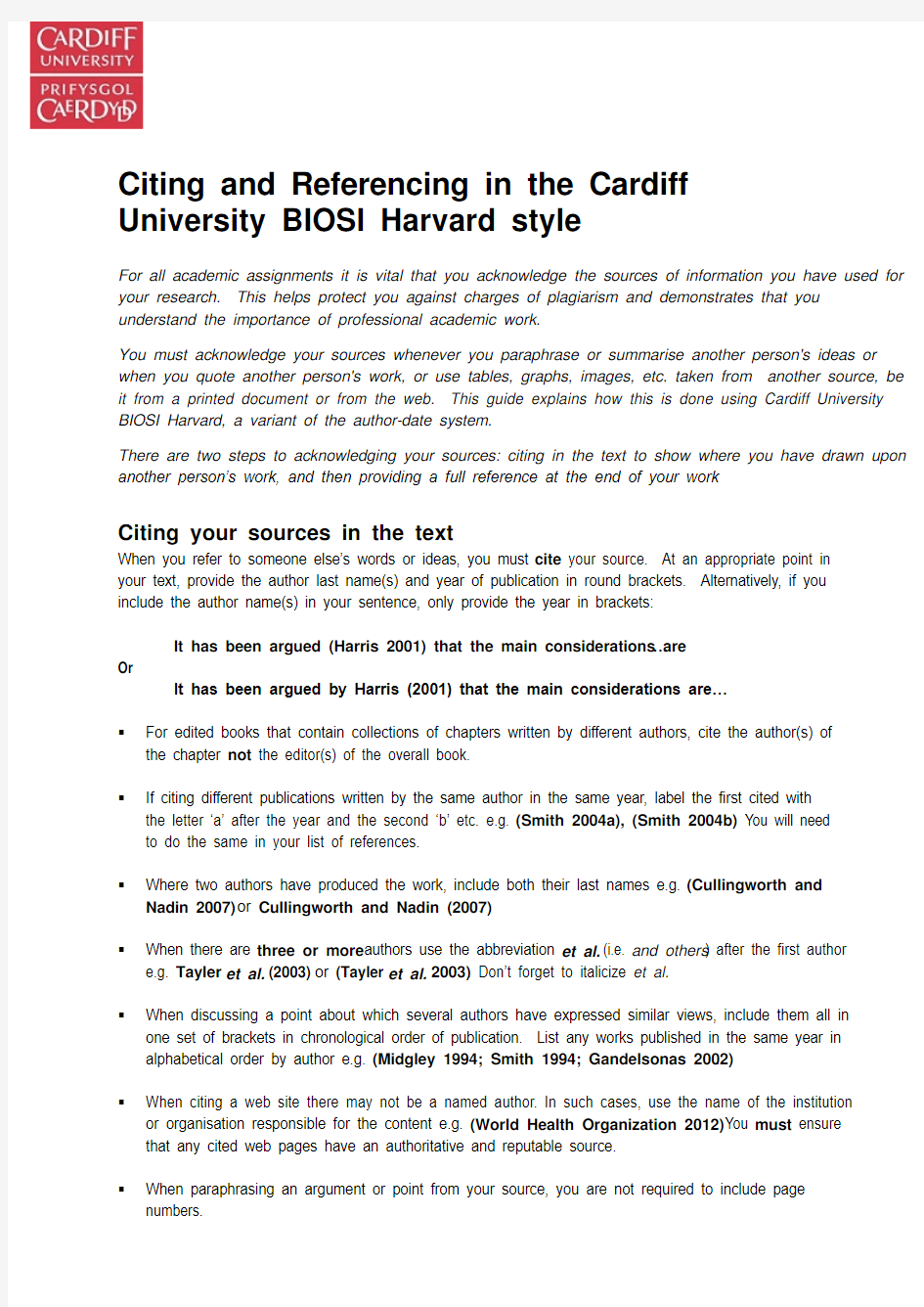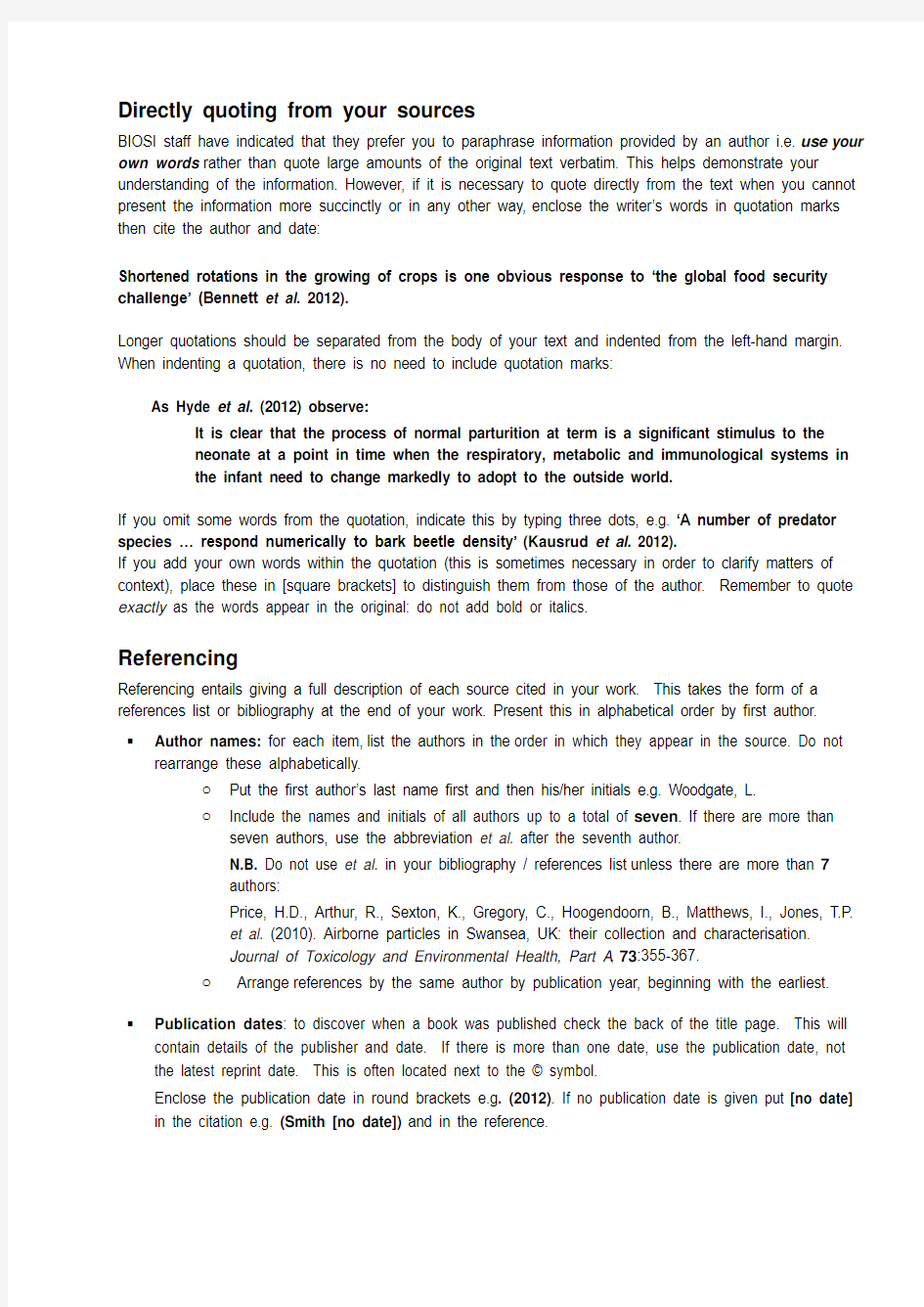Reference rule


Citing and Referencing in the Cardiff
University BIOSI Harvard style
For all academic assignments it is vital that you acknowledge the sources of information you have used for your research. This helps protect you against charges of plagiarism and demonstrates that you understand the importance of professional academic work.
You must acknowledge your sources whenever you paraphrase or summarise another person's ideas or when you quote another person's work, or use tables, graphs, images, etc. taken from another source, be it from a printed document or from the web. This guide explains how this is done using Cardiff University BIOSI Harvard, a variant of the author-date system.
There are two steps to acknowledging your sources: citing in the text to show where you have drawn upon another person’s work, and then providing a full reference at the end of your work
Citing your sources in the text
When you refer to someone else’s words or ideas, you must cite your source. At an appropriate point in your text, provide the author last name(s) and year of publication in round brackets. Alternatively, if you include the author name(s) in your sentence, only provide the year in brackets:
It has been argued (Harris 2001) that the main considerations are…
Or
It has been argued by Harris (2001) that the main considerations are…
?For edited books that contain collections of chapters written by different authors, cite the author(s) of the chapter not the editor(s) of the overall book.
?If citing different publications written by the same author in the same year, label the first cited with the letter ‘a’ after the year and the second ‘b’ etc. e.g. (Smith 2004a), (Smith 2004b). You will need to do the same in your list of references.
?Where two authors have produced the work, include both their last names e.g. (Cullingworth and Nadin 2007) or Cullingworth and Nadin (2007).
?When there are three or more authors use the abbreviation et al. (i.e. and others) after the first author
e.g. Tayler et al. (2003) or (Tayler et al. 2003). Don’t forget to italicize et al.
?When discussing a point about which several authors have expressed similar views, include them all in one set of brackets in chronological order of publication. List any works published in the same year in alphabetical order by author e.g. (Midgley 1994; Smith 1994; Gandelsonas 2002).
?When citing a web site there may not be a named author. In such cases, use the name of the institution or organisation responsible for the content e.g. (World Health Organization 2012). You must ensure that any cited web pages have an authoritative and reputable source.
?When paraphrasing an argument or point from your source, you are not required to include page numbers.
Directly quoting from your sources
BIOSI staff have indicated that they prefer you to paraphrase information provided by an author i.e. use your own words rather than quote large amounts of the original text verbatim. This helps demonstrate your understanding of the information. However, if it is necessary to quote directly from the text when you cannot present the information more succinctly or in any other way, enclose the writer’s words in quotation marks then cite the author and date:
Shortened rotations in the growing of crops is one obvious response to ‘the global food security chall enge’ (Bennett et al. 2012).
Longer quotations should be separated from the body of your text and indented from the left-hand margin. When indenting a quotation, there is no need to include quotation marks:
As Hyde et al. (2012) observe:
It is clear that the process of normal parturition at term is a significant stimulus to the
neonate at a point in time when the respiratory, metabolic and immunological systems in
the infant need to change markedly to adopt to the outside world.
If you omit some words from the quotation, indicate this by typing three dots, e.g. ‘A number of predator species … respond numerically to bark beetle density’ (Kausrud et al. 2012).
If you add your own words within the quotation (this is sometimes necessary in order to clarify matters of context), place these in [square brackets] to distinguish them from those of the author. Remember to quote exactly as the words appear in the original: do not add bold or italics.
Referencing
Referencing entails giving a full description of each source cited in your work. This takes the form of a references list or bibliography at the end of your work. Present this in alphabetical order by first author.
?Author names: for each item,list the authors in the order in which they appear in the source. Do not rearrange these alphabetically.
o Put the first author’s last name first and then his/her initials e.g. Woodgate, L.
o Include the names and initials of all authors up to a total of seven. If there are more than seven authors, use the abbreviation et al. after the seventh author.
N.B. Do not use et al. in your bibliography / references list unless there are more than 7
authors:
Price, H.D., Arthur, R., Sexton, K., Gregory, C., Hoogendoorn, B., Matthews, I., Jones, T.P.
et al. (2010). Airborne particles in Swansea, UK: their collection and characterisation.
Journal of Toxicology and Environmental Health, Part A, 73:355-367.
o Arrange references by the same author by publication year, beginning with the earliest.
?Publication dates: to discover when a book was published check the back of the title page. This will contain details of the publisher and date. If there is more than one date, use the publication date, not the latest reprint date. This is often located next to the ? symbol.
Enclose the publication date in round brackets e.g. (2012). If no publication date is given put [no date] in the citation e.g. (Smith [no date]) and in the reference.
?Editions: the cover or back of the title page should tell you the edition of the book. State this in numerals not words (12th ed. not Twelfth ed.). There is no need to specify that a book is the 1st ed.
Fox, S.I. (2011). Human Physiology. 12th ed. New York: McGraw-Hill.
?Publishers: omit peripheral terms in publisher names e.g. John Wiley not John Wiley & Sons, Bodley Head not Bodley Head Inc.
?Capitalisation:
o capitalize the first letter of each author’s last name and each initial e.g. BéruBé, K.A.
o capitalize the first letter of each main word of book, thesis and report titles e.g. L ife: the S cience of B iology
o capitalize the first word only of journal article titles e.g. P opulation dynamics in changing environments
o capitalize each significant word of a journal publication name e.g T rends in C ell B iology
o capitalize all first letters of a place name and publisher e.g. C ambridge, MA: H arvard UP.
?Italicization: use italics for the title of a journal publication (but not for the title of the journal article), also for titles of theses, web pages and for the titles of books from which you are referencing a specific chapter or section (see examples on p.4).
?Bold: the volume number of a journal should appear in bold font e.g. Genetic Medicine12:634-640.
Web sources
If no personal author is given, web pages can be referenced using the name of the organisation responsible.
A good web site should have sufficient ownership details to enable you to cite it. If not, you should question whether the source is of sufficient quality. Include the following:
Author or Organisation. (Publication Date). Document title [Online].Place (if identified): Publisher.
Available at: web address of document [Accessed: date you viewed the site].
e.g. Centers for Disease Control and Prevention. (2011). Learn about health literacy [Online].
Atlanta, GA: CDC. Available at: https://www.360docs.net/doc/a48558169.html,/healthliteracy/Learn/index.html [Accessed:
23 May 2012].
Secondary referencing
Where possible, aim to reference from the original source. However, sometimes you may need to cite an author whose work you have not personally read, but whose work is presented or summarised by the author of a publication you have consulted. This can be referenced as follows:
Rondinelli (1983), cited in Potts (2002), descri bes the stages of a project…
or
A process project might consist of a number of stages including experimentation and
production (Rondinelli 1983, cited in Potts 2002).
In your references list you should include the source you have actually read, i.e. Potts not Rondinelli.
For further help or information contact Science Library - Tel: 029 2087 4085. Email:scilby@https://www.360docs.net/doc/a48558169.html, BIO-018-Q-1 / August 2012 / NJM Also available in alternative formats.
